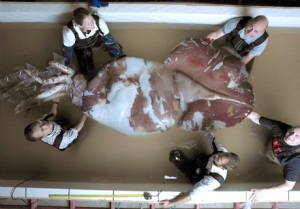Genetic analysis of octopodes indicates that they developed in the ocean around Antarctica. They spread out from that continent when an ice sheet covered it and created cold water currents in all directions to the north.
By Alister Doyle, Environment Correspondent
OSLO (Reuters) – Many octopuses evolved from a common ancestor that lived off Antarctica more than 30 million years ago, according to a “Census of Marine Life” that is seeking to map the oceans from microbes to whales.
The $650 million census is on track for completion in 2010, assessing about 230,000 known marine species, a statement said. It has identified 5,300 likely new species, of everything from fish or corals. So far, 110 have been confirmed as new.
Among the findings, genetic evidence showed that the tentacles of the octopus family pointed to an Antarctic ancestor for many deep sea species. A modern octopus called Adelieledone in Antarctica seemed the closest relative of the original.
Octopuses apparently spread around the world after Antarctica became covered with a continent-wide ice sheet more than 30 million years ago, a shift that helped create oxygen-rich ocean currents flowing north, a report said.
“Isolated in new habitat conditions, many different species evolved; some octopuses, for example, losing their defensive ink sacs — pointless at perpetually dark depths,” the census said.
Classification: Biota > Animalia (Kingdom) > Mollusca (Phylum) > Conchifera (Subphylum) > Cephalopoda (Class) > Coleoidea (Subclass) > Octopodiformes (Superorder) > Octopoda (Order) > Incirrata (Suborder) > Octopodoidea (Superfamily) > Octopodidae (Family) > Adelieledone Allcock et al., 20















